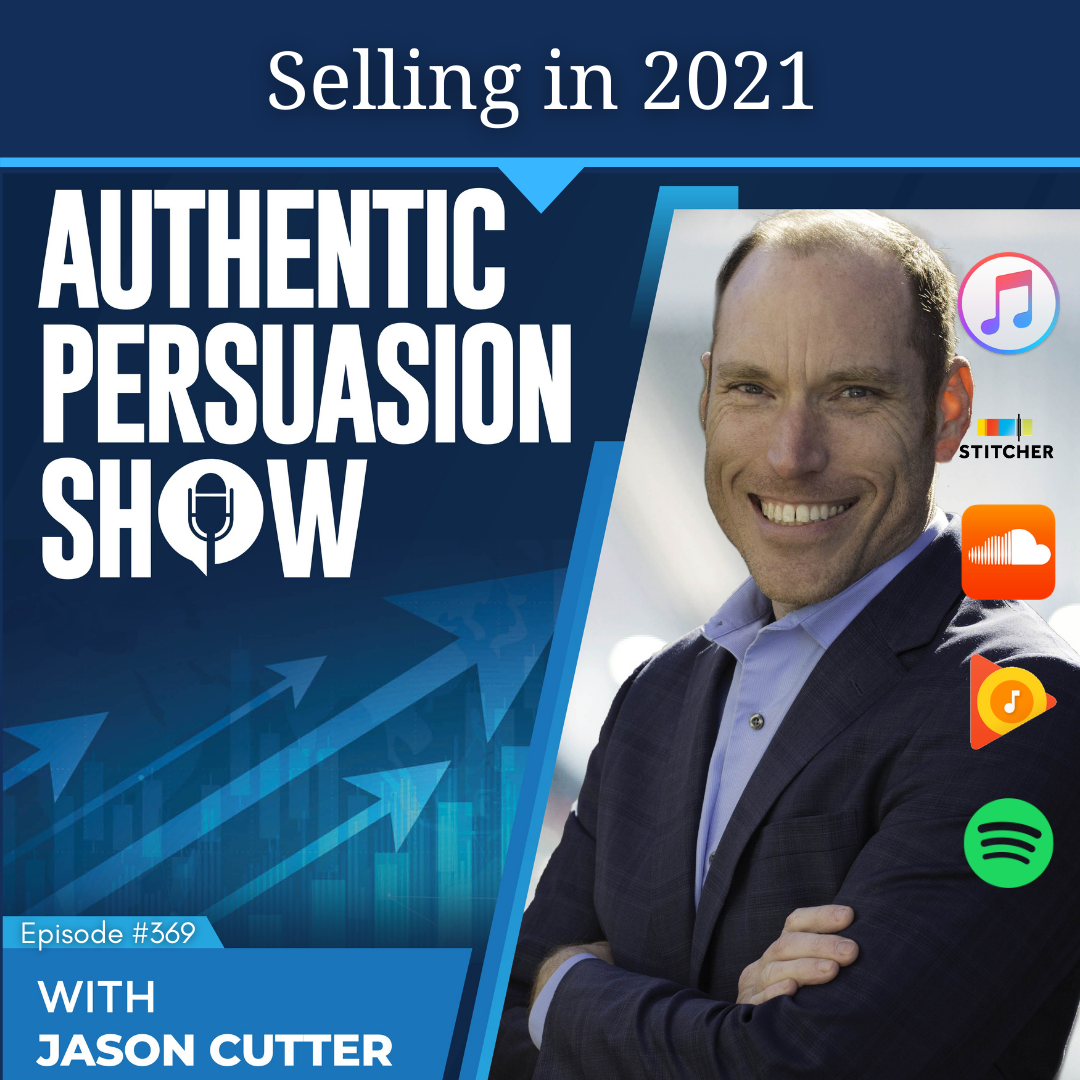Episode Transcript
Most people will agree that the right ratio for success is you talking about a third of the time, the prospect talking the other two thirds of the time. Welcome to the sales experience podcast, the show for salespeople and sales leaders, where we help you create the ideal sales experience to generate raving fan customers.
Grab your notepad and get ready for actionable steps. You can use to change sales from a dirty word to an active service for your prospects. Now for your host, Jason Cutter.
I am so glad that you're here. I'm so glad that you're taking the time to hopefully up level your sales career or your sales team by listening to podcasts like this. Hopefully you've subscribed. If not, make sure to subscribe. And if you like this, leave a rating and a review. And in this episode, I am going to address some sales related questions.
To try to help everybody in sales do more, be more, and sell more with their career and achieve their goals. Now, let's go ahead and jump into this episode. This time it comes from Chance Harmon. So here's the question that Chance sent to me. How do you handle objections best? Buying signals. How do you get out of a slump and a follow up process?
There's four questions in there. So I'm going to try to unpack as many of those as I can in our time together. So let's look at the first one. So how do you handle objections best? The key is with that one is really listening. Now this might sound weird. And of course people say, I listen. And why does that matter?
I know what I'm doing. The challenge is that a lot of times. People are too busy salespeople, especially if you're new, especially if you're struggling, too busy thinking about what you have to do next or say next or what you're going to respond with as soon as they're done talking. Instead, what you want to do is listen.
And we've all done this in our own lives, in our own conversations. We've had other people do us as well. where you're talking and you're explaining something and you can see that other person has literally stopped listening because all they can do is wait for you to take a breath so they can jump in with some kind of response or their own story or make it about them, whatever that is.
And so salespeople do that a lot. So one of the best things for handling objections is to actually just listen and then understand, is this an objection? Is this a hard stop? Is this a big issue or is it just a question? Because there's different levels where people are. Sometimes asking questions, sometimes like this is a deal breaker.
Like you either overcome this thing or else, and you want to be able to hear that difference and understand that one of the best things to do for handling objections, in my opinion, is to always keep your answers as short as possible. Most questions, most issues or objections that come up generally can be answered with either a yes or no, or a very short sentence, a few words. The key is to do that. What I see a lot of salespeople do when they're more in order taker mode or they're insecure about what they're selling or their own skills is they ramble a lot. They give long answers where they're just going on and on relative to what they think would solve the issue at hand and overcome that objection.
And they're just throwing lots of stuff out and They go down this long rabbit hole of different responses, different things. Sometimes it doesn't even make sense. The problem with that is that when you do it, it's subconsciously triggering the prospect to worry. Because now instead of you giving confident short answers, you're giving long rambling answers.
And that seems like a red flag. Otherwise, it should have been a yes or no. Is there a fee? Yes. Can I cancel anytime? Yes. Is there a contract? Yes. Will this hurt my credit? No. Like you should have the ability to answer those questions like a professional would without long winded answers. The more you can do that, the more you can answer and then just move on.
Always remember answer and then move on. Keep going. All right. Second one is how do you handle buying signals? So without knowing specifically what you're selling chance, the key is when you want to pick up on those signals and then you want to move the conversation forward without stopping. If you're getting those signals, if someone says, Hey, this is interesting, what do we do next?
Look at that, pick up on that and then respond with that's perfect. That's great question. Next step is X, Y, and Z. Hey, it's Jason here. We'll be right back to the podcast, but first, are you ready to change the way you view your selling role and become a sales professional? Do you have a team that is hungry for new ways to improve and grow?
If so, I have various coaching and consulting programs available. That might be great tools to help you achieve your goals. To learn more about the ways we can work together and to book your free sales power call, go to Jason cutter. com. Now let's get back to the episode. A lot of times people get stuck in their sales process where they feel like they have to do certain things in a certain order.
And then when that buying signal comes up, they totally ignore it because. They don't know what to do. It's outside of their process. And so they just continue forward and you could lose sales that way. So always when you see buying signals is just assess where would that take you in the conversation and then move forward and then don't stop.
If somebody gives you a buying signal, just assume that they want to buy at that point. And then don't stop. A lot of people then go back to asking for the sale and bringing up other stuff. Just see that as the express lane. Just go straight to it. All right. Next on the list was how do you get out of a slump?
This is the topic probably for a whole nother discussion. The key with getting out of a slump is you've got to understand what got you there in the first place. My guess is when it comes to sales slumps, is there something you're doing now that wasn't there before? For my guests, based on just hundreds and hundreds of sales reps and listening to, I don't even know, maybe thousands of hours of sales calls over my leadership and management career is that most of the time what happens is going back into the first things we've been talking about already.
Sales reps over talk. They over explain. I mentioned this in a previous answer to a question which was talking about where people don't handle things very well and they over talk instead of listening. It's all in this. And so generally what happens is when you're in a slump in sales, it's because you flipped the ratio of being successful in that conversation.
Now, what's that ratio? Most people will agree that the right ratio for success is you talking about a third of the time, the prospect talking the other two thirds of the time. Most salespeople, once they get to the point where they think they know it all and they understand it and they think they're just in charge and their goal is to just talk or they're just insecure, what happens is they talk more than the prospect and the prospect feels like you don't care because all you're doing is talking about you.
You, your product, your service, your company, your awards, your ratings, everything online, your other customers, the other logos you work with, the people you've helped, like it's all about you. And people don't want to hear that there's some of that's valid. Some of that's important for building some level of trust to understanding that yes, you're a professional and your organization is here and it's going to last.
But nobody wants to hear these long monologues about how awesome you are. And the problem is that sales preps do that. Once they feel like they've arrived, they throw the script out the window, and then they go into their own zone. And the challenge is they're not listening. They're talking more and listening less.
The prospect is listening or is talking less. And so the first thing always, if you're in a sales slump that I recommend to everyone, if you have one, is to get the script out of the drawer. That's probably underneath all your snacks. And it's just just crumpled up and you can't remember the last time you used it.
If you have a script, pull that out and go back to using it. Generally, what happens is right away, you'll be successful. If you don't have a script, do the same thing as that advice with the script, which is to follow the script in the process that worked for you at one point. And really, when in doubt, Ask lots of questions.
That is the key. The more questions you can ask, the more you get them talking, and that will pull you out of the slump because now they're talking, you're listening, and then you're solving. That's the biggest thing. All right. So for follow process, really the key is if we look at the advice from the last one for getting out of the slump.
And then you take that and you apply that to understanding what the prospect actually needs and wants and how you can solve it. If you can answer the question of why would they want to buy from you? If you can do that. Then your follow up process is much simpler because now you're not having to chase somebody hoping they're going to buy.
You know why they should buy. And then your follow ups are going to have a much different tone. So hopefully that helps chance. Thank you for the question. And I know that this was a long one, but a lot of things wanted to pack in there. Are you looking for a way to increase your selling effectiveness?
Breakthrough plateaus and achieve your financial goals through sales. When you use the authentic persuasion method, you will transform from order taker to quota breaker. If you're ready to become an authentic persuader, go to Jason cutter. com to download the free ebook. And if you want to get help on getting there even quicker for yourself or your sales team, set up your free sales power call, and I will give you some tips and strategies to help in your conversations.
And also make recommendations on ways that we can work together. When you're ready, go to Jason cutter. com again, Jason cutter. com. You can find all the links you need at Jason cutter. com and also set up your free sales power call. And no matter what, keep in mind that everything in life is sales and people remember the experience you gave them.
![[E225] Objections, Buying Signals, Slumps, and Follow-Ups (Q&A)](https://episodes.castos.com/salesexperiencepodcast/images/TSEP-Cover-APQA.png)


